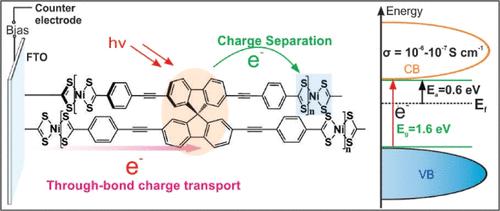当前位置:
X-MOL 学术
›
ACS Appl. Mater. Interfaces
›
论文详情
Our official English website, www.x-mol.net, welcomes your feedback! (Note: you will need to create a separate account there.)
Metal–Carbodithioate-Based 3D Semiconducting Metal–Organic Framework: Porous Optoelectronic Material for Energy Conversion
ACS Applied Materials & Interfaces ( IF 9.5 ) Pub Date : 2023-05-31 , DOI: 10.1021/acsami.3c04200 Xinlin Li 1 , Ryther Anderson 2 , H Christopher Fry 3 , Saied Md Pratik 4 , Wenqian Xu 5 , Subhadip Goswami 6 , Taylor G Allen 7 , Jierui Yu 1 , Sreehari Surendran Rajasree 1 , Christopher J Cramer 4 , Garry Rumbles 7, 8 , Diego A Gómez-Gualdrón 2 , Pravas Deria 1
ACS Applied Materials & Interfaces ( IF 9.5 ) Pub Date : 2023-05-31 , DOI: 10.1021/acsami.3c04200 Xinlin Li 1 , Ryther Anderson 2 , H Christopher Fry 3 , Saied Md Pratik 4 , Wenqian Xu 5 , Subhadip Goswami 6 , Taylor G Allen 7 , Jierui Yu 1 , Sreehari Surendran Rajasree 1 , Christopher J Cramer 4 , Garry Rumbles 7, 8 , Diego A Gómez-Gualdrón 2 , Pravas Deria 1
Affiliation

|
Solar energy conversion requires the working compositions to generate photoinduced charges with high potential and the ability to deliver charges to the catalytic sites and/or external electrode. These two properties are typically at odds with each other and call for new molecular materials with sufficient conjugation to improve charge conductivity but not as much conjugation as to overly compromise the optical band gap. In this work, we developed a semiconducting metal–organic framework (MOF) prepared explicitly through metal–carbodithioate “(−CS2)nM” linkage chemistry, entailing augmented metal–linker electronic communication. The stronger ligand field and higher covalent character of metal–carbodithioate linkages─when combined with spirofluorene-derived organic struts and nickel(II) ion-based nodes─provided a stable, semiconducting 3D-porous MOF, Spiro-CS2Ni. This MOF lacks long-range ordering and is defined by a flexible structure with non-aggregated building units, as suggested by reverse Monte Carlo simulations of the pair distribution function obtained from total scattering experiments. The solvent-removed “closed pore” material recorded a Brunauer–Emmett–Teller area of ∼400 m2/g, where the “open pore” form possesses 90 wt % solvent-accessible porosity. Electrochemical measurements suggest that Spiro-CS2Ni possesses a band gap of 1.57 eV (σ = 10–7 S/cm at −1.3 V bias potential), which can be further improved by manipulating the d-electron configuration through an axial coordination (ligand/substrate), the latter of which indicates usefulness as an electrocatalyst and/or a photoelectrocatalyst (upon substrate binding). Transient-absorption spectroscopy reveals a long-lived photo-generated charge-transfer state (τCR = 6.5 μs) capable of chemical transformation under a biased voltage. Spiro-CS2Ni can endure a compelling range of pH (1–12 for weeks) and hours of electrochemical and photoelectrochemical conditions in the presence of water and organic acids. We believe this work provides crucial design principles for low-density, porous, light-energy-conversion materials.
中文翻译:

基于金属-二硫代碳酸盐的 3D 半导体金属-有机骨架:用于能量转换的多孔光电材料
太阳能转化需要工作组合物产生具有高电势的光生电荷以及将电荷输送到催化位点和/或外部电极的能力。这两种特性通常相互矛盾,需要新的分子材料具有足够的共轭以提高电荷电导率,但共轭又不能过度损害光学带隙。在这项工作中,我们开发了一种半导体金属-有机骨架 (MOF),通过金属-碳硫酸盐“(−CS 2 ) nM”连接化学,需要增强的金属-连接体电子通信。金属-硫代碳酸酯键的更强配体场和更高共价特性——当与螺芴衍生的有机支柱和镍 (II) 离子基节点结合时——提供了稳定的半导体 3D 多孔 MOF,Spiro-CS 2 Ni。这种 MOF 缺乏长程排序,并且由具有非聚合构建单元的灵活结构定义,正如从总散射实验中获得的对分布函数的反向蒙特卡罗模拟所建议的那样。去除溶剂的“闭孔”材料记录了约 400 m 2 /g 的 Brunauer-Emmett-Teller 面积,其中“开孔”形式具有 90 wt% 的溶剂可及孔隙率。电化学测量表明 Spiro-CS 2Ni 的带隙为 1.57 eV(σ = 10 –7 S/cm,在 −1.3 V 偏置电位),可以通过轴向配位(配体/底物)操纵 d 电子构型进一步改善,后者为这表明可用作电催化剂和/或光电催化剂(基于底物结合)。瞬态吸收光谱揭示了一种长寿命的光生电荷转移态 (τ CR = 6.5 μs),能够在偏置电压下进行化学转化。Spiro-CS 2在存在水和有机酸的情况下,Ni 可以承受令人信服的 pH 范围(1-12 数周)和数小时的电化学和光电化学条件。我们相信这项工作为低密度、多孔、光能转换材料提供了关键的设计原则。
更新日期:2023-05-31
中文翻译:

基于金属-二硫代碳酸盐的 3D 半导体金属-有机骨架:用于能量转换的多孔光电材料
太阳能转化需要工作组合物产生具有高电势的光生电荷以及将电荷输送到催化位点和/或外部电极的能力。这两种特性通常相互矛盾,需要新的分子材料具有足够的共轭以提高电荷电导率,但共轭又不能过度损害光学带隙。在这项工作中,我们开发了一种半导体金属-有机骨架 (MOF),通过金属-碳硫酸盐“(−CS 2 ) nM”连接化学,需要增强的金属-连接体电子通信。金属-硫代碳酸酯键的更强配体场和更高共价特性——当与螺芴衍生的有机支柱和镍 (II) 离子基节点结合时——提供了稳定的半导体 3D 多孔 MOF,Spiro-CS 2 Ni。这种 MOF 缺乏长程排序,并且由具有非聚合构建单元的灵活结构定义,正如从总散射实验中获得的对分布函数的反向蒙特卡罗模拟所建议的那样。去除溶剂的“闭孔”材料记录了约 400 m 2 /g 的 Brunauer-Emmett-Teller 面积,其中“开孔”形式具有 90 wt% 的溶剂可及孔隙率。电化学测量表明 Spiro-CS 2Ni 的带隙为 1.57 eV(σ = 10 –7 S/cm,在 −1.3 V 偏置电位),可以通过轴向配位(配体/底物)操纵 d 电子构型进一步改善,后者为这表明可用作电催化剂和/或光电催化剂(基于底物结合)。瞬态吸收光谱揭示了一种长寿命的光生电荷转移态 (τ CR = 6.5 μs),能够在偏置电压下进行化学转化。Spiro-CS 2在存在水和有机酸的情况下,Ni 可以承受令人信服的 pH 范围(1-12 数周)和数小时的电化学和光电化学条件。我们相信这项工作为低密度、多孔、光能转换材料提供了关键的设计原则。


























 京公网安备 11010802027423号
京公网安备 11010802027423号